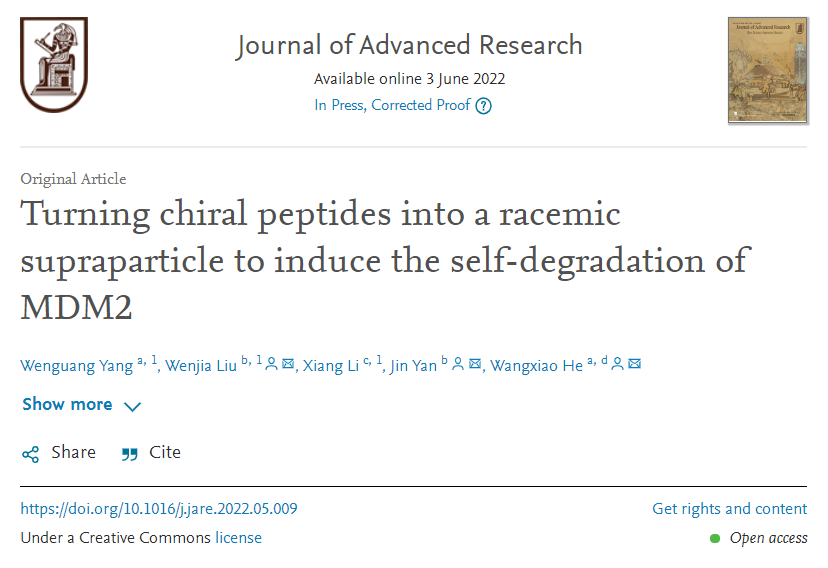Recently, Yang Wenguang, a postgraduate student from the First Affiliated Hospital of Xi 'an Jiaotong University (XJTU) published an article entitled Turning Chiral Peptides into a Racemic Supraparticle to Induce the Self-Degradation of MDM2 in Journal of Advanced Research as the first author.

Chirality is immanent in biomolecules. By using this molecular asymmetry in life activities, chiral molecules can achieve their pharmacological action through chiral matching with biomolecules and molecular conformation recognition, which is considered as a feasible strategy for new drug development. Although many successes have been achieved in the development of chiral therapeutics by small molecular compounds, significant challenges still remain regarding to clinical translation of therapeutic chiral peptides.

Design of polypeptide-derived homo-PROTAC molecule MSDc and its nano-engineering strategy
To overcome the pharmacological obstacles of polypeptides and promote the clinical translation, Yang Wenguang, a postgraduate student from Department of Medical Oncology of our hospital and his team members designed a D-peptide as MDM2 Self-Degradation catalysts (MSDc) based on previous research of the screening and design of polypeptide, which can regulate the intracellular MDM2 concentration by inducing the self-degradation of a carcinogenic E3 ubiquitin ligase termed MDM2 via the chemically linked dimerization of a MMD2 binding D-peptide. MSDc can not only effectively target intracellular protein interactions, but also enhance the resistance against enzymatic hydrolysis of peptide and increase the uptake by cancer cells. To further overcome the pharmaceutical obstacles of D-peptides and design peptide-derived chiral supramolecularnanomedicines with suitable pharmaceutical properties for clinical translation, the team developed a mild and simple self-assembly strategy to turn D-peptide MSDc as the building block into a spherical supraparticle—MSDNc by exploiting a metal coordination between mercaptan in peptides and trivalent gold ion (as shown in the figure above). Because of the flexibility of the gold-sulfur interface, this chiral gold spherical supraparticle undergone racemization, which eliminated the consume from the T-lymphocyte/macrophage phagocytose in the circulation of D-enantiomeric peptides. MSDNc supramolecule inherits and strengthens the anti-enzymatic properties of MSDc. Besides, it possesses the capability of disassembly with the controllability of intracellular redox.It can restore p53 level through targeted degradation of intracellular MDM2, thereby synergistically enhancing the anti-tumor effect of anti-pd1 immunotherapy.